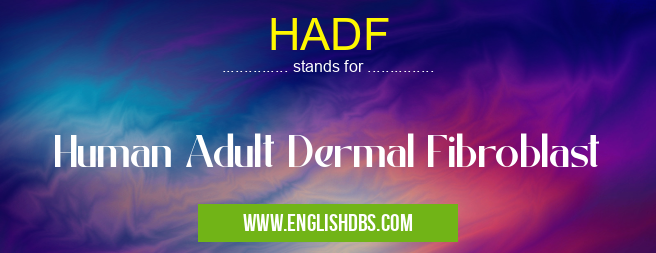What does HADF mean in MEDICAL
Human Adult Dermal Fibroblasts (HADF) are human cells found in the skin that are important for wound healing and tissue repair. These cells play a key role in maintaining healthy skin and preventing scarring, sun damage, and other skin conditions. HADF can be isolated from both healthy and diseased dermal tissue, making them useful for studying diseases of the skin. Because of their ability to quickly proliferate in culture, HADF can also be used for cell-based assays as well as drug discovery.

HADF meaning in Medical in Medical
HADF mostly used in an acronym Medical in Category Medical that means Human Adult Dermal Fibroblast
Shorthand: HADF,
Full Form: Human Adult Dermal Fibroblast
For more information of "Human Adult Dermal Fibroblast", see the section below.
What are Human Adult Dermal Fibroblasts?
Human adult dermal fibroblasts are specialized connective tissue cells that form part of the extracellular matrix in the skin. They provide structure and strength to the skin while also producing collagen, elastin, and other types of proteins essential for wound healing. The interaction between these fibroblasts and neighboring epidermal cells is critical for maintaining a healthy barrier function within the skin.
How Are Human Adult Dermal Fibroblasts Used?
HADF can be cultured in vitro to study many aspects of dermal physiology such as collagen synthesis, gene expression patterns, cellular behavior under various conditions, and drug interactions. Research with HADF helps us to better understand how our bodies respond to damage or disease at the cellular level. In addition to this research potential, HADF have been clinically used to treat burns since 1991. By placing specially prepared sheets of HADF onto a burn site, doctors can help promote faster healing due to their unique properties such as forming a protective layer over damaged skin or stimulating growth factor production at the wound site.
Essential Questions and Answers on Human Adult Dermal Fibroblast in "MEDICAL»MEDICAL"
What is a Human Adult Dermal Fibroblast?
A Human Adult Dermal Fibroblast (HADF) cell is a type of fibroblast found in connective tissue. It plays an important role in synthesizing and maintaining the extracellular matrix, which provides the structural framework of a tissue.
What is a primary cell culture?
Primary cell culture is a process where cells derived from tissue are cultured and maintained in vitro under controlled conditions. HADF cells are usually extracted from human skin biopsies or neonatal foreskin to form primary cell cultures.
Why use HADF cells for research?
HADFs provide researchers with easy access to human biological samples, which can be used for various studies like drug development and cosmetic testing. Additionally, this type of cell has been studied extensively, making data collection easier and more reliable.
Are there any potential risks associated with using HADF cells?
As with any biological sample, there are potential risks associated with using HADF cells. These include pathogen contamination and genetic mutations due to numerous passages in culture over time. To minimize these risks it's essential to work with reputable suppliers who adhere to quality control standards.
How long do HADF cultures typically last?
The lifespan of an HADF culture can vary depending on storage conditions and the characteristics of the individual donor sample, but it's typically safe to assume cultures will last up to several weeks if properly maintained.
Is it possible to freeze down HADF cultures?
Yes, it is possible to freeze down HADF cultures for future use or resuse without detrimental effect on their performance provided the proper freezing techniques are employed such as dimethyl sulfoxide (DMSO).
What happens during human dermal fibroblast isolation?
During the isolation process, different media composition will be used at various stages in order to separate out the target fibroblasts from unwanted debris or other types of cells within the sample. This is typically followed by extended cultivation steps until pure populations of adult dermal fibroblasts have been achieved.
Final Words:
In summary, Human Adult Dermal Fibroblasts (HADF) are vital for maintaining healthy skin and repairing tissue damage. Through extensive research with these special cells, scientists now have an improved understanding of how our bodies heal themselves after injury or disease onset. They are also clinically used to treat burn victims by creating protective layers over damaged areas or stimulating growth factors necessary for healing. By utilizing their vast capabilities in an ever-growing number of applications—both scientific research studies and clinical therapies—HADF will continue to play an important role in furthering our knowledge about human health.
